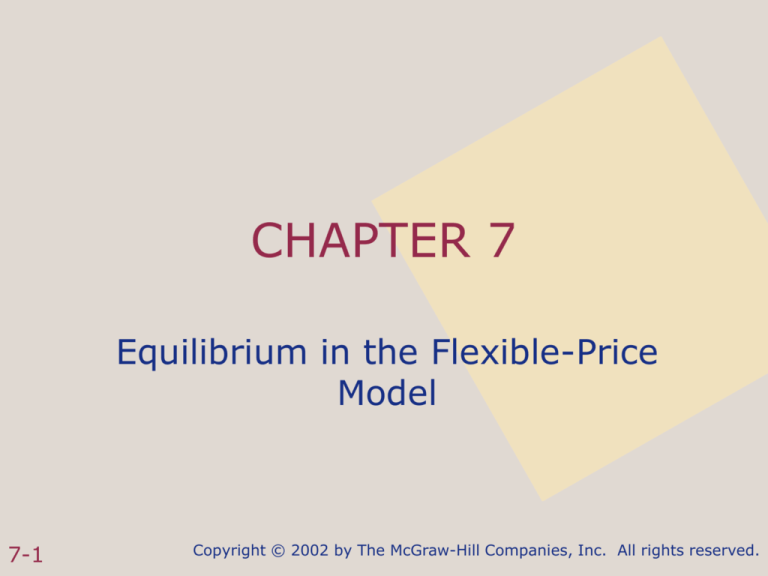
CHAPTER 7
Equilibrium in the Flexible-Price
Model
7-1
Copyright © 2002 by The McGraw-Hill Companies, Inc. All rights reserved.
Questions
• When wages and prices are flexible,
what economic forces keep total
production equal to aggregate
demand?
• Why does the flow-of-funds through
financial markets have to balance?
• What are the components of savings
flowing into financial markets?
7-2
Copyright © 2002 by The McGraw-Hill Companies, Inc. All rights reserved.
Questions
• What is a “comparative statics”
analysis?
• What are “supply shocks”?
• What are “real business cycles”?
7-3
Copyright © 2002 by The McGraw-Hill Companies, Inc. All rights reserved.
Flexible-Price Model
C C0 Cy (1 - t) Y
Y Y*
GG
I I0 Ir r
f
NX (X yf Y ) (X 0 ) - (X r r)
f
(X r r ) - (IMy Y)
f
0 - r (r - r )
7-4
Copyright © 2002 by The McGraw-Hill Companies, Inc. All rights reserved.
Flexible-Price Model
• Aggregate demand is the sum of
the four components of expenditure
(E)
• In equilibrium, aggregate demand will
equal real GDP (Y)
E C I G NX Y
7-5
Copyright © 2002 by The McGraw-Hill Companies, Inc. All rights reserved.
Flexible-Price Model
• The real interest rate (r) plays the key
balancing role in making sure that the
economy reaches and stays at
equilibrium
• To understand how, we need to
examine the market in which the real
interest rate functions as the price
– the market for loanable funds
7-6
Copyright © 2002 by The McGraw-Hill Companies, Inc. All rights reserved.
The Flow-of-Funds
• The circular-flow principle ensures
that if supply equals demand in the
flow-of-funds through financial
markets, then real GDP will be equal
to aggregate demand
Y Y* C I G NX
Y * -C - G - NX I
(Y * -C - T) (T - G) - NX I
7-7
Copyright © 2002 by The McGraw-Hill Companies, Inc. All rights reserved.
The Flow-of-Funds
(Y * -C - T) (T - G) - NX I
• The right-hand side of the equation is
investment
– the demand for loanable funds
• The left-hand side of the equation is
total savings from households, the
government, and foreigners
– the supply of loanable funds
7-8
Copyright © 2002 by The McGraw-Hill Companies, Inc. All rights reserved.
Figure 7.1 - The Flow-of-Funds through
Financial Markets
7-9
Copyright © 2002 by The McGraw-Hill Companies, Inc. All rights reserved.
The Flow-of-Funds
• (Y*-C-T) = households’ savings
• (T-G) = government savings
• (-NX) = the net flow of purchasing
power that foreigners channel into
domestic financial markets
– dollars earned by foreigners selling
imports above what is needed to buy our
exports are used to purchase domestic
assets
7-10
Copyright © 2002 by The McGraw-Hill Companies, Inc. All rights reserved.
Figure 7.2 - Imports Minus Exports Equal the
Capital Inflow
7-11
Copyright © 2002 by The McGraw-Hill Companies, Inc. All rights reserved.
Flow-of-Funds Equilibrium
• Equilibrium occurs in the loanable
funds market when the supply of
loanable funds (saving) is equal to the
demand for loanable funds
(investment)
(Y * -C - T) (T - G) - NX I
7-12
Copyright © 2002 by The McGraw-Hill Companies, Inc. All rights reserved.
Figure 7.3 - Equilibrium in the Flow-of-Funds
7-13
Copyright © 2002 by The McGraw-Hill Companies, Inc. All rights reserved.
Flow-of-Funds Equilibrium
(Y * -C - T) (T - G) - NX I
• If the left-hand side > right-hand side
– financial institutions will find purchasing
power piling up
– they will try to underbid their competitors
by accepting a lower interest rate
– as the interest rate falls, the amount of
investment will increase
– the process will continue until equilibrium
is reached
7-14
Copyright © 2002 by The McGraw-Hill Companies, Inc. All rights reserved.
Figure 7.4 - Excess Supply of Savings in the
Flow-of-Funds
7-15
Copyright © 2002 by The McGraw-Hill Companies, Inc. All rights reserved.
Solving the Model
• The determinants of saving are
Y * -C - T [1 - t - (1 - t)Cy ]Y * -C0
T - G tY * -G
f
- NX IMy Y Xrr - Xyf Y - X0 - Xrr
f
• The supply of saving is upward sloping
– when the interest rate rises, the total
savings flow increases
7-16
Copyright © 2002 by The McGraw-Hill Companies, Inc. All rights reserved.
Solving the Model
• The demand for loanable funds is the
investment function
I I0 Irr
• The demand for loanable funds is
downward sloping
– when the interest rate rises, investment
falls
7-17
Copyright © 2002 by The McGraw-Hill Companies, Inc. All rights reserved.
Solving the Model
• Equilibrium occurs where the supply
of savings is equal to investment
{[1 - t - (1 - t)Cy ]Y * -C0 } {tY * -G}
f
f
{IMy Y X rr - X yf Y - X 0 - X rr }
I0 - Irr
7-18
Copyright © 2002 by The McGraw-Hill Companies, Inc. All rights reserved.
Solving the Model
• Solving for the real interest rate (r)
(C0 I0 G)
r
(Ir X r )
-
7-19
(X yf Y f X 0 X rr f )
(Ir X r )
{1 - [(1 - t)Cy - IMy ]}Y *
(Ir X r )
Copyright © 2002 by The McGraw-Hill Companies, Inc. All rights reserved.
Solving the Model: An Example
•
•
•
•
•
•
•
Y*=$10,000 billion
C0=$3,000 billion
I0=$1,000 billion
G=$2,000 billion
t=25%
Cy=0.67
IMy=0.2
•
•
•
•
•
•
Xyf=0.1
Yf=$10,000 billion
0=100
X=10
Ir=9,000
r=600
(6,000) (2,000) - (7,000)
r
0.0667
15,000
7-20
Copyright © 2002 by The McGraw-Hill Companies, Inc. All rights reserved.
Solving the Model: An Example
• At an equilibrium interest rate=6.67%
– private savings=-$500 billion
– government savings=$500 billion
– capital inflow from abroad (-NX)=$400
billion
– total saving is $400 billion
– investment is $400 billion
• The flow-of-funds through financial
markets balances
7-21
Copyright © 2002 by The McGraw-Hill Companies, Inc. All rights reserved.
Solving the Model: An Example
• At an equilibrium interest rate=6.67%
– consumption spending=$8,000 billion
– investment spending=$400 billion
– government purchases=$2,000 billion
– net exports=-$400 billion
– total expenditure=$10,000 billion
– potential output=$10,000 billion
• Aggregate demand is equal to real
GDP
7-22
Copyright © 2002 by The McGraw-Hill Companies, Inc. All rights reserved.
Comparative Statics
• We can determine the response of the
economy to a particular shift in the
economic environment or policy
– first, look at the initial equilibrium
position of the economy
– second, look at the equilibrium position of
the economy after the shift
– last, identify the difference in the two
equilibrium positions as the change in the
economy in response to the shift
7-23
Copyright © 2002 by The McGraw-Hill Companies, Inc. All rights reserved.
An Increase in Government
Purchases
• Policy makers decide to increase
annual government purchases by G
– no change in consumption [C=0]
– change in investment due to the change
in the interest rate [I=-Irr]
– change in net exports due to the change
in the interest rate [NX=-Xrr]
– no change in potential output or real GDP
[Y= Y*=0]
7-24
Copyright © 2002 by The McGraw-Hill Companies, Inc. All rights reserved.
An Increase in Government
Purchases
Y C I G NX
0 0 - Ir r G - X r r
• Solving for r
G
r
Ir X r
7-25
Copyright © 2002 by The McGraw-Hill Companies, Inc. All rights reserved.
Figure 7.5 - Flow of Funds: An Increase in
Government Purchases
7-26
Copyright © 2002 by The McGraw-Hill Companies, Inc. All rights reserved.
An Increase in Government
Purchases
• More government purchases mean
less government savings
– the real interest rate rises
– the quantity of funds demanded for
investment falls
– the amount of international saving
flowing into domestic financial markets
rises
– the exchange rate falls
7-27
Copyright © 2002 by The McGraw-Hill Companies, Inc. All rights reserved.
An Increase in Government
Purchases
Y 0
C 0
- Ir
I
G
Ir X r
G G
- X r
NX
G
Ir X r
- X
G
Ir X r
7-28
Copyright © 2002 by The McGraw-Hill Companies, Inc. All rights reserved.
An Increase in Government
Purchases
• The increase in government purchases
leads to an increase in interest rates
– the higher real interest rates leads to a
drop in investment and an appreciation in
the home currency
– the appreciation in the home currency
leads to a decline in net exports
– the decline in net exports and investment
equal the increase in government
purchases
7-29
Copyright © 2002 by The McGraw-Hill Companies, Inc. All rights reserved.
Figure 7.6 - The Interest Rate, the Exchange
Rate, and the Capital Inflow
7-30
Copyright © 2002 by The McGraw-Hill Companies, Inc. All rights reserved.
Figure 7.8 - The Impact of a Change in the
Domestic Interest Rate on the Exchange Rate
7-31
Copyright © 2002 by The McGraw-Hill Companies, Inc. All rights reserved.
A Decrease in Tax Rates
• The effects of a cut in tax rates are
very similar but not identical to an
increase in government purchases
– a tax cut increases household incomes,
leading to a rise in consumption and
household saving
7-32
Copyright © 2002 by The McGraw-Hill Companies, Inc. All rights reserved.
Investors Become More
Optimistic
• If investors become more optimistic,
I0 will rise by I0
– no change in consumption or government
purchases [C=G=0]
– change in investment due to the change
in optimism and the change in the
interest rate [I=I0-Irr]
– change in net exports due to the change
in the interest rate [NX=-Xrr]
7-33
Copyright © 2002 by The McGraw-Hill Companies, Inc. All rights reserved.
Investors Become More
Optimistic
Y C I G NX
0 0 I0 - Ir r 0 - X r r
• Solving for r
I0
r
Ir X r
7-34
Copyright © 2002 by The McGraw-Hill Companies, Inc. All rights reserved.
Figure 7.9 - Flow of Funds: An
Investment Boom
7-35
Copyright © 2002 by The McGraw-Hill Companies, Inc. All rights reserved.
Investors Become More
Optimistic
• The increase in investment increases
the demand for loanable funds
– the real interest rate rises
– the amount of international saving
flowing into domestic financial markets
rises
– the exchange rate falls
– net exports falls
7-36
Copyright © 2002 by The McGraw-Hill Companies, Inc. All rights reserved.
Investors Become More
Optimistic
Y 0
C 0
X r
I
I0
Ir X r
G 0
- X r
NX
I0
Ir X r
- r
I0
Ir X r
7-37
Copyright © 2002 by The McGraw-Hill Companies, Inc. All rights reserved.
Figure 7.10 - The International
Consequences of an Investment Boom
7-38
Copyright © 2002 by The McGraw-Hill Companies, Inc. All rights reserved.
An Increase in Foreign
Interest Rates
• The foreign real interest rate rises by
rf
– change in net exports due to the changes
in both foreign and domestic interest
rates [NX=-Xr(r-rf )]
– change in investment due to the change
in the domestic interest rate [I=-Irr]
– no change in consumption or government
purchases [C=G=0]
7-39
Copyright © 2002 by The McGraw-Hill Companies, Inc. All rights reserved.
An Increase in Foreign
Interest Rates
Y C I G NX
f
0 0 - Ir r 0 - X r (r - r )
• Solving for r
f
X r r
r
Ir X r
7-40
Copyright © 2002 by The McGraw-Hill Companies, Inc. All rights reserved.
An Increase in Foreign
Interest Rates
Y 0
C 0
G 0
f
f
X r r
X r r
I Ir
NX Ir
Ir X r
Ir X r
f
r r
Ir
Ir X r
7-41
Copyright © 2002 by The McGraw-Hill Companies, Inc. All rights reserved.
Figure 7.11 - Flow-of-Funds: An Increase in
Interest Rates Abroad
7-42
Copyright © 2002 by The McGraw-Hill Companies, Inc. All rights reserved.
An Increase in Foreign
Interest Rates
• The rise in foreign interest rates
reduces the supply of loanable funds
– the domestic real interest rate rises (but
by less than the increase in the foreign
interest rate)
– the amount of investment falls
– the exchange rate rises
– net exports rises
7-43
Copyright © 2002 by The McGraw-Hill Companies, Inc. All rights reserved.
Figure 7.12 - The Real Exchange Rate and
Domestic Interest Rates
7-44
Copyright © 2002 by The McGraw-Hill Companies, Inc. All rights reserved.
A Decline in Confidence in
the Currency
• If foreign exchange speculators lose
confidence in the currency, 0 will
change by 0
– change in net exports due to the change
in both the domestic interest rate and
confidence [NX=X0 -Xrr]
– change in investment due to the change
in the domestic interest rate [I=-Irr]
– no change in consumption or government
purchases [C=G=0]
7-45
Copyright © 2002 by The McGraw-Hill Companies, Inc. All rights reserved.
A Decline in Confidence in
the Currency
Y C I G NX
0 0 - Ir r 0 X 0 - X r r
• Solving for r
X 0
r
Ir X r
7-46
Copyright © 2002 by The McGraw-Hill Companies, Inc. All rights reserved.
A Decline in Confidence in
the Currency
Y 0
C 0
- Ir
I
X 0
Ir X r
G 0
Ir X 0
NX
Ir X r
Ir 0
Ir X r
7-47
Copyright © 2002 by The McGraw-Hill Companies, Inc. All rights reserved.
Figure 7.13 - Flow of Funds: A Decline in
Exchange Rate Confidence
7-48
Copyright © 2002 by The McGraw-Hill Companies, Inc. All rights reserved.
A Decline in Confidence in
the Currency
• The drop in confidence decreases the
supply of saving
– the
– the
– the
– net
7-49
real interest rate rises
amount of investment falls
exchange rate rises
exports rises
Copyright © 2002 by The McGraw-Hill Companies, Inc. All rights reserved.
Supply Shocks
• Supply shocks are shocks that
change aggregate supply and
potential output (Y*)
– changes in oil prices
– new inventions and innovations
• When a supply shock occurs, real GDP
does change because potential output
changes
7-50
Copyright © 2002 by The McGraw-Hill Companies, Inc. All rights reserved.
An Adverse Supply Shock
• Suppose oil prices rise and potential
output falls by Y*
– change in consumption due to the change
in income [C=Cy(1-t)Y*]
– change in investment due to the change
in the interest rate [I=-Irr]
– change in net exports due to the changes
in both the interest rate and income
[NX=-Xrr-IMyY*]
– no change in government purchases
[G=0]
7-51
Copyright © 2002 by The McGraw-Hill Companies, Inc. All rights reserved.
An Adverse Supply Shock
Y C I G NX
Y Cy (1 - t)Y * -Ir r 0 - X r r - IMy Y *
• Solving for r
1 - Cy (1 - t) IMy
Y *
r
Ir X r
7-52
Copyright © 2002 by The McGraw-Hill Companies, Inc. All rights reserved.
Figure 7.14 - Flow of Funds: An Adverse
Supply Shock
7-53
Copyright © 2002 by The McGraw-Hill Companies, Inc. All rights reserved.
An Adverse Supply Shock
• The drop in real GDP lowers income
and reduces household saving
– the real interest rate rises
– the amount of investment falls
– the amount of international saving
flowing into domestic financial markets
rises
– the exchange rate falls
– net exports falls
7-54
Copyright © 2002 by The McGraw-Hill Companies, Inc. All rights reserved.
An Adverse Supply Shock
C Cy (1 - t)Y *
G 0
1 IMy - Cy (1 - t)
I Ir
Y *
Ir X r
1 IMy - Cy (1 - t)
NX X r
Y *
Ir X r
1 IMy - Cy (1 - t)
r
Y *
Ir X r
7-55
Copyright © 2002 by The McGraw-Hill Companies, Inc. All rights reserved.
Real Business Cycles
• Economist Joseph Schumpeter
believed that changes in technology
were the principal force driving
business cycles
– booms occurred when new technology
diffused rapidly throughout the economy
– periods of relative stagnation occurred
when the pace of technological innovation
and diffusion was much slower
7-56
Copyright © 2002 by The McGraw-Hill Companies, Inc. All rights reserved.
A Shift in Technology
• Suppose a shift in technology occurs
that involves two components
– a sudden increase in the efficiency of
labor
– a sudden rise in investment demand
• This shock will have both supply and
demand components
– potential output will rise
– there is an increase in the demand for
funds
7-57
Copyright © 2002 by The McGraw-Hill Companies, Inc. All rights reserved.
A Shift in Technology
• To examine the effects of such a
change, we can add together the
effects of a supply shock to the effects
of an increase in investment demand
1 - Cy (1 - t) IMy
I0
Y *
r
Ir X r
Ir X r
7-58
Copyright © 2002 by The McGraw-Hill Companies, Inc. All rights reserved.
Figure 7.15 - Flow of Funds: A
Schumpeterian Combined Productivity and
Investment Shock
7-59
Copyright © 2002 by The McGraw-Hill Companies, Inc. All rights reserved.
A Shift in Technology
• Higher productivity
– household savings increase as incomes
rise
– this will put downward pressure on the
interest rate
• Increase in investment demand
– this will put upward pressure on interest
rates
• The end result depends on which
effect is dominant
7-60
Copyright © 2002 by The McGraw-Hill Companies, Inc. All rights reserved.
A Shift in Technology
C Cy (1 - t)Y *
G 0
1 IMy - Cy (1 - t)
X r
I
I0 Ir
Y *
Ir X r
Ir X r
1 IMy - Cy (1 - t)
X r I0
NX X r
Y * Ir X r
Ir X r
1 IMy - Cy (1 - t)
r I0
r
Y * Ir X r
Ir X r
7-61
Copyright © 2002 by The McGraw-Hill Companies, Inc. All rights reserved.
A Shift in Technology
• This technology shock produced
–a
–a
–a
–a
rise in output
sharp rise in investment
decline in the exchange rate
decrease in net exports
• These shifts in the economy are
typically found in a business cycle
boom
7-62
Copyright © 2002 by The McGraw-Hill Companies, Inc. All rights reserved.
Real Business Cycle Theory
• While the real business cycle theory
may be able to explain booms
– it contains no mention of changes in
unemployment
• full employment is assumed throughout
– it is unable to fully explain recessions or
depressions
7-63
Copyright © 2002 by The McGraw-Hill Companies, Inc. All rights reserved.
Chapter Summary
• When the economy is at full
employment, real GDP is equal to
potential output
• In a flexible-price economy, the
interest rate shifts in response to
changes in policy or the economic
environment to keep real GDP equal
to potential output
7-64
Copyright © 2002 by The McGraw-Hill Companies, Inc. All rights reserved.
Chapter Summary
• The real interest rate balances the
supply of loanable funds committed to
financial markets by savers with the
demand for funds to finance
investments. The circular-flow
principle guarantees that when
savings equals investment, aggregate
demand and real GDP will equal
potential output
7-65
Copyright © 2002 by The McGraw-Hill Companies, Inc. All rights reserved.
Chapter Summary
• How does the full-employment
equilibrium of an economy shift in
response to economic policy or shocks
to the economic environment?
– This is what the flexible-price
macroeconomic model can analyze
• Supply shocks are sharp, sudden
changes in costs that shift the
efficiency of labor
7-66
Copyright © 2002 by The McGraw-Hill Companies, Inc. All rights reserved.
Chapter Summary
• Real business cycle theory attempts to
use this chapter’s model to account
for not just changes in the short-run
composition of real GDP but changes
in the short-run level of real GDP as
well
– it may be (and it may not be) a good
theory for booms, but it is hard to see
how it could ever become a good
explanation of recessions or depressions
7-67
Copyright © 2002 by The McGraw-Hill Companies, Inc. All rights reserved.






